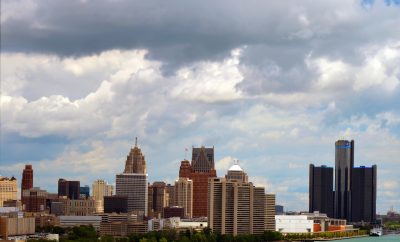
Crime
Can We Rebuild Detroit? Affirmative Thoughts
Detroit filed for bankruptcy last July with over $18 billion in debt, the biggest municipal collapse in the history of the United States. The city also has the highest crime rate among all large cities in the country, which exacerbates its economic hardships even more. Our report, Crime in America: Top 10 Most Dangerous Cities Over 200,000 notes that unemployment, population reduction, slow police responses and a vast amount of abandoned buildings may be correlated with high crime rates in the city. According to Time Magazine, “Detroit is in particularly bad shape, many of its underlying issues — crushing debt and unfunded and unsustainable retiree benefits — are not unique.”
The country’s industrialization brought not only economic advancements and prosperity to the United States, but income inequality and multi-ethnicity problems to its cities. Detroit became known during the late 1950-60s as the “Motor City” or “Motown” due to the large concentration of automobile companies in its metropolitan area. Its freeway system was also constructed during industrial revolution, and facilitated the development of the city and its rapid industrialization.
However, instead of simply discussing the unfortunate economic and social hardships within the city, we should focus on what options Detroit really has for recovery!
Any suggestions?
Detroit is a city with a rich history and vibrant atmosphere, but high crime rates spoil all odds for its residents. Former Detroit Chief of Police and current Wayne County Sheriff, Benny Napoleon, reaffirmed this in his article in the Huffington Post, claiming that Detroit lost more than half of its population due to disorganized neighborhoods and high crime rates. He also proposed a Five Point Crime Reduction Plan, that should include but not be limited to the following:
– Data-driven approach
– Crime prevention
– Directed enforcement
– Problem-oriented policing
– Community policing
Sounds like a solid plan to me if staff training and implementation procedures are utilized systematically and correctly.
What has Detroit already done?!
There is a plethora of existing initiatives that have been adopted by the Detroit Police Department. Neighborhood Watch, for example provides the main line of communication between police and the community. Another useful crime prevention strategy is Citizen Observer, which is, in essence, a mobile platform that “provides updates of crimes trends, description of wanted suspects, missing persons, crime prevention tips, and other pertinent information pertaining to businesses and the community safety.” Other notable programs include Detroit’s Most Wanted and the Community and Police Advocacy (CAPPA) group, both of which equip the community with useful information and work directly with the public on a range of safety issues.
As we can see, the Detroit Police are vigorously trying to bring city crime down through community-oriented policing strategies, but one practice looks quite alarming to me: the Offender Tracking Information System (OTIC), which, according to its website, will “provide information about any offender who is, or was, in a Michigan prison, on parole or probation under the supervision of the MDOC, has transferred in or out of Michigan under the Michigan Interstate Compact, or who has escaped or absconded from their sentence.” The practice is disturbing because it can be easily misused by people to label and harass ex-offenders. It undoubtedly raises many ethical concerns.
Besides police initiatives, the Detroit community is trying to revitalize its neighborhoods to create a safe environment for all residents. The Helping Ourselves Overcome Disparities Project (Osborn HOOD) uses efforts from different city and neighborhood organizations to engage youth in community building and provide more mobility and safety to the Osborn area residents of Detroit. Osborne HOOD is an excellent example of community leadership and progressive thinking. Detroit should welcome similar initiatives in its backyard that can provide positive spillover effects and facilitate such projects on a larger scale.
Data and Necessary Surroundings
I strongly agree with the Five Point Crime Reduction Plan proposed by Benny Napoleon. Napoleon served as Detroit’s youngest Chief of Police and later became a prominent Assistant Wayne County Executive. As a longtime resident of Detroit with a 38-year public service career, he knows what is best for the city. Another important notion that he supports is the idea that comprehensive data collection is paramount in combating crime. The data-driven approach focuses on collecting and using data so we can understand patterns and try to reduce incidents of crime across neighborhoods. It’s truly a starting point for any preventive actions as well as for adequate respons times.
However, in addition to data gathering and analysis, Detroit needs systematic research on ecology of crime to understand where crime incidents are located to find the so-called “hot spots.” Crime Prevention Through Environmental Design (CPTED) can be utilized to make the public spaces safer. Some changes can be quite pricey, but Detroit can start with the small pieces of the puzzle that are relatively inexpensive, effective, and easy to incorporate. Small adjustments of neighborhood spaces like the replacement of blind spots with safer architectural designs, or changing the layout of streets to bolster neighbors’ interactions and provide a greater sense of community. Neighborhood watch groups should be also utilized in every community to better understand needs and the most pressing problems. The above examples are just the tip of the iceberg among the many innovative ways that CPTED can offer to transform criminogenic spaces into safe communities.
Detroit can learn a great deal about CPTED by looking at Irvine, California, which was rated the number one safest city over 200,000 population in 2012 according to our methodology. The city was carefully planned by Irvine Company in the 1960s utilizing some notions of CPTED. Omar Masry, an associate planner in the City of Irvine, California claims that implementation of CPTED in Irvine “enhances the sense of safety and security for new occupants and the surrounding neighborhood.” Using the same strategy for Detroit can render significant results in reducing its crime rates and reorganizing its communities.
So, Can We Rebuild, or Can’t We?
If we want crime reduction strategies to work in Detroit, strong police cooperation not only with communities, but with other sectors of local government, should be implemented. To eradicate “hot spots” of crime in Detroit we will need to “rebuild” the city by changing existing environments and providing safer opportunities for its residents. Communities should come together without having to wait for government and police to magically alter existing realities. The real change will happen when all human resources are pulled together including local government officials, police officers, community leaders, young professionals and educators.
It has been long proven that alone we can do so little, while together we can do so much.
—
Valeriya Metla is a young professional, passionate about international relations, immigration issues, and social and criminal justice. She holds two Bachelor Degrees in regional studies and international criminal justice. Contact Valeriya at staff@LawStreetMedia.com.
Featured image courtesy of [Gwert38 via Wikipedia]








Comments